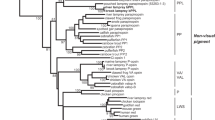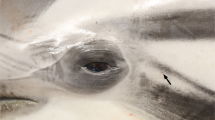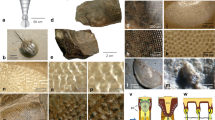Abstract
IN 1936 Young1 described a structure in several genera of octopods (cephalopods) appearing on the ventral surface of both stellate ganglia (near the base of the stellar nerve most distal to the mantle connective) which he termed the “epistellar body”. From histological considerations he hypothesized that this body might have a neurosecretory function. Nishioka et al.2 reinvestigated this structure in Octopus in more detail and, by electron microscopy, made the significant observation that the epistellar body contains cells the surfaces of which display microvilli suggesting rhabdomeric structures as seen typically in molluscan and arthropod visual photoreceptors. Later Nishioka et al.3 extended their investigations to include Eledone moschata and presented not only further electron micrograph data on the rhabdomeric ultrastructure but also biochemical data indicating the presence of a rhodopsin photopigment. Thus these investigators argued that the neurone-like cells of the epistellar body could be photo-receptors. We present here electrophysiological evidence clearly indicating the presence of photoreceptor cells in the epistellar body. There is already electrophysiological evidence for extracellular photoreceptors in arthropods4–7, molluscs8,9 and for photoreceptors in the diencephalon of the frog10,11.
This is a preview of subscription content, access via your institution
Access options
Subscribe to this journal
Receive 51 print issues and online access
$199.00 per year
only $3.90 per issue
Buy this article
- Purchase on Springer Link
- Instant access to full article PDF
Prices may be subject to local taxes which are calculated during checkout
Similar content being viewed by others
References
Young, J. Z., Quart. J. Microsc. Sci., 78, 311 (1936).
Nishioka, R. S., Hagedorn, I. R., and Bern, H. A., Z. Zellforsch., 57, 406 (1962).
Nishioka, R. S., Yasamasu, Y., Packard, A., Bern, H. A., and Young, J. Z., Z. Zellforsch., 75, 301 (1966).
Kennedy, D., J. Gen. Physiol., 46, 551 (1963).
Gwilliam, G. F., Biol. Bull., 125, 470 (1963); 129, 244 (1965).
Millecchia, R., Bradbury, J., and Mauro, A., Science, 154, 1199 (1966).
Zwicky, K. T., Life Sci., 7, 257, Part II (1968).
Arvanitaki, A., and Chalazonitis, N., in Nervous Inhibition (edit. by Florey, E.), 194 (Pergamon, 1961).
Kennedy, D., J. Gen. Physiol., 44, 277 (1960).
Dodt, E., and Jacobson, M., J. Neurophysiol., 26, 752 (1963).
Dodt, E., and Morita, Y., Vision Res., 4, 413 (1964).
Boycott, B. B., and Young, J. Z., in Bertil Hanström (edit. by Wingstrand, K. G.) (Lund Zool. Inst., 1959).
Haefilfinger, H. R., Rev. Suisse de Zool., 61, 153 (1954).
Messenger, J. B., Nature, 213, 836 (1967).
Nishioka, R. S., Simpson, L., and Bern, H. A., Veliger, 7, 1 (1964).
Simpson, L., Bern, H. A., and Nishioka, R. S., Gen. Comp. Endocrinol., 7, 525 (1966).
Author information
Authors and Affiliations
Rights and permissions
About this article
Cite this article
MAURO, A., BAUMANN, F. Electrophysiological Evidence of Photoreceptors in the Epistellar Body of Eledone moschata. Nature 220, 1332–1334 (1968). https://doi.org/10.1038/2201332a0
Received:
Revised:
Issue Date:
DOI: https://doi.org/10.1038/2201332a0
This article is cited by
-
Morphology and function of the photoexcitable neurones in the central ganglia ofOnchidium verruculatum
Journal of Comparative Physiology ? A (1975)
-
The function of photoexcitive neurones in the central ganglia for behavioral activity of the marine mollusc,Onchidium verruculatum
Journal of Comparative Physiology (1973)
-
Light-evoked Impulses from Extra-ocular Photoreceptors in the Squid Todarodes
Nature (1972)
Comments
By submitting a comment you agree to abide by our Terms and Community Guidelines. If you find something abusive or that does not comply with our terms or guidelines please flag it as inappropriate.



